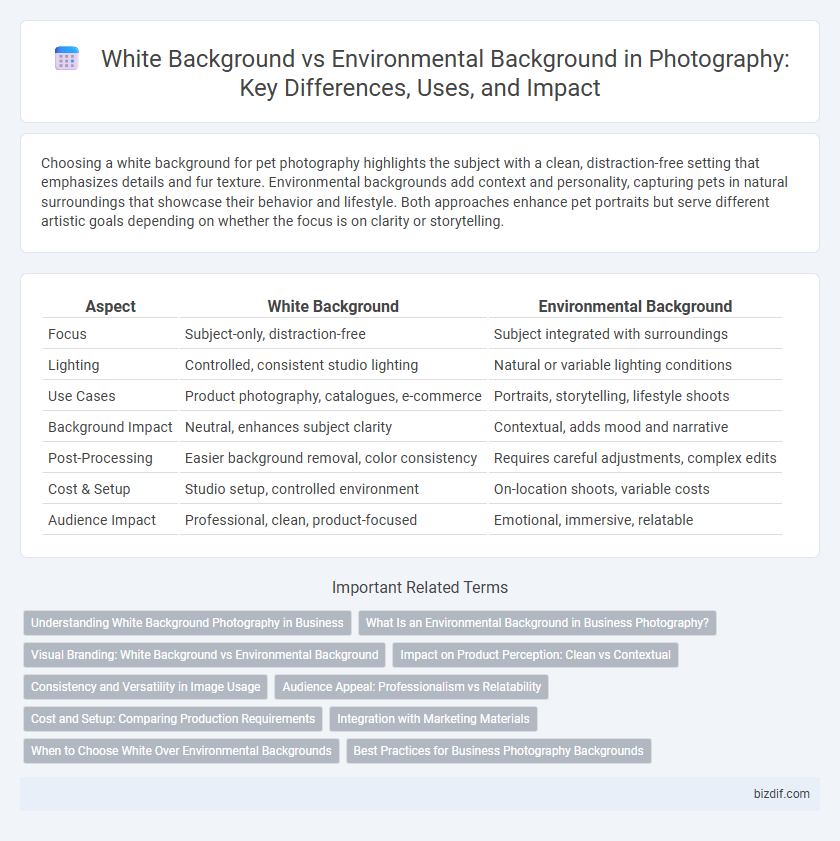Choosing a white background for pet photography highlights the subject with a clean, distraction-free setting that emphasizes details and fur texture. Environmental backgrounds add context and personality, capturing pets in natural surroundings that showcase their behavior and lifestyle. Both approaches enhance pet portraits but serve different artistic goals depending on whether the focus is on clarity or storytelling.
Table of Comparison
| Aspect | White Background | Environmental Background |
|---|---|---|
| Focus | Subject-only, distraction-free | Subject integrated with surroundings |
| Lighting | Controlled, consistent studio lighting | Natural or variable lighting conditions |
| Use Cases | Product photography, catalogues, e-commerce | Portraits, storytelling, lifestyle shoots |
| Background Impact | Neutral, enhances subject clarity | Contextual, adds mood and narrative |
| Post-Processing | Easier background removal, color consistency | Requires careful adjustments, complex edits |
| Cost & Setup | Studio setup, controlled environment | On-location shoots, variable costs |
| Audience Impact | Professional, clean, product-focused | Emotional, immersive, relatable |
Understanding White Background Photography in Business
White background photography in business enhances product visibility by eliminating distractions, ensuring the item is the focal point for potential customers. This technique improves consistency across catalogs and e-commerce platforms, facilitating a clean, professional look that aligns with brand identity. Utilizing a pure white backdrop also aids in accurate color representation and simplifies post-processing for marketers and designers.
What Is an Environmental Background in Business Photography?
An environmental background in business photography captures subjects within their natural or work settings, enhancing authenticity and context. This approach highlights the professional atmosphere, tools, and surroundings relevant to the subject's industry, making the imagery more relatable and engaging. Unlike white backgrounds, environmental backgrounds provide visual storytelling that supports brand identity and marketing goals.
Visual Branding: White Background vs Environmental Background
White background photography enhances visual branding by providing a clean, distraction-free canvas that highlights the product's features and maintains consistency across e-commerce platforms. Environmental background images create a storytelling effect, showcasing the product in real-life settings that build emotional connections and convey brand lifestyle values. Balancing both backgrounds strategically can strengthen brand identity by combining clarity with contextual relevance.
Impact on Product Perception: Clean vs Contextual
A white background emphasizes product clarity by eliminating distractions, highlighting details and form for a clean, professional appearance that enhances focus on the item itself. Environmental backgrounds provide contextual storytelling, showcasing the product in realistic settings that evoke lifestyle aspirations and functional use, thereby establishing emotional connections. Choosing between white and environmental backgrounds influences consumer perception by balancing visual simplicity against immersive narrative appeal.
Consistency and Versatility in Image Usage
White backgrounds provide consistent, distraction-free settings that enhance image uniformity across diverse platforms, ideal for product photography and e-commerce. Environmental backgrounds offer versatility by adding contextual storytelling and natural elements, which enrich visual narratives and engage viewers more deeply. Choosing between the two depends on the need for consistent branding versus dynamic image variety tailored for specific marketing objectives.
Audience Appeal: Professionalism vs Relatability
White backgrounds create a clean, distraction-free setting that enhances professionalism and highlights the subject, appealing to audiences seeking polished, corporate-style images. Environmental backgrounds offer context and storytelling, making photos more relatable and engaging for viewers who value authenticity and real-life scenarios. Choosing between the two depends on the desired audience connection--professionalism for business-focused imagery and relatability for lifestyle or creative projects.
Cost and Setup: Comparing Production Requirements
White background photography demands minimal setup with consistent lighting and backdrop investment, resulting in lower production costs ideal for e-commerce and product shoots. Environmental background photography involves variable outdoor or on-location setups, often requiring additional permits, equipment, and time, increasing overall expenses. Choosing between the two depends on budget constraints and the desired aesthetic impact of the final images.
Integration with Marketing Materials
White backgrounds provide a clean, minimalist aesthetic that ensures product images seamlessly integrate with diverse marketing materials and maintain visual consistency across catalogs, e-commerce sites, and advertisements. Environmental backgrounds add contextual storytelling, enhancing brand messaging by showcasing products in relatable settings that resonate with target audiences and increase engagement rates. Choosing between white and environmental backgrounds affects how well images complement promotional content, influencing overall brand perception and conversion effectiveness.
When to Choose White Over Environmental Backgrounds
White backgrounds are ideal when the focus is solely on the subject, such as product photography or professional headshots, providing a clean, distraction-free look that enhances detail and color accuracy. Environmental backgrounds work best in lifestyle or editorial photography, where context adds storytelling elements and emotional depth. Choosing white over environmental backgrounds depends on the need for simplicity, versatility in post-processing, and consistent lighting conditions to highlight features without competing visual elements.
Best Practices for Business Photography Backgrounds
Selecting the ideal background for business photography hinges on purpose and brand identity, with white backgrounds offering a clean, distraction-free focus on products or subjects, enhancing clarity and professionalism in e-commerce or corporate portraits. Environmental backgrounds provide context and storytelling by showcasing the subject in a relevant setting, which effectively conveys brand personality and establishes emotional connections with the audience. Balancing lighting techniques, background consistency, and subject placement ensures optimal visual impact, maintaining a cohesive brand experience across all business photography applications.
White Background vs Environmental Background Infographic

 bizdif.com
bizdif.com